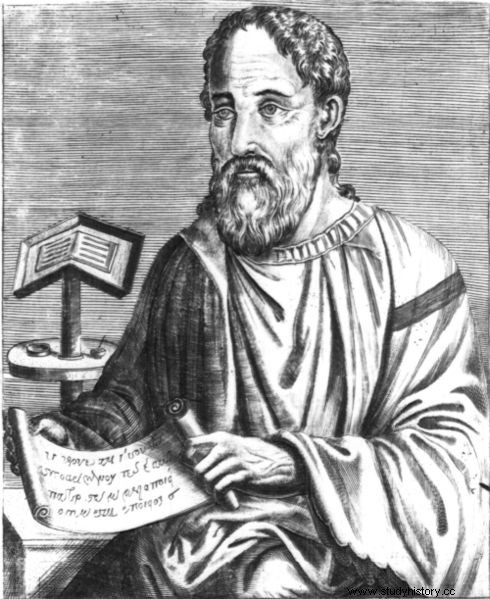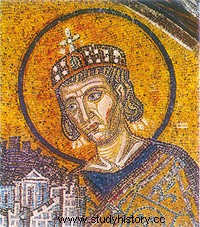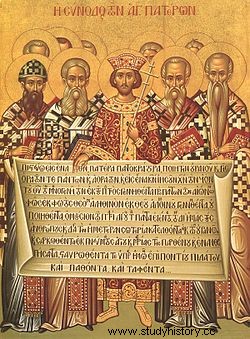 Eusebius of Caesarea, or Eusebius of Palestine as he is also known, lived through a troubled period that ended with the consolidation of Christianity as the predominant religion in the Roman Empire. The last years of the third century AD. and the first from the 4th century AD. they signify the end of religious persecution, culminating in the promulgation of the Edict of Milan in 313 AD. In the political field, the emperor Constantine, after a long series of civil wars, will end up definitively rising to power in the year 324 AD. after defeating Licinius. For the Church these are also troubled times because of heresies:Donatism in the West and Arianism in the East shook their doctrinal unity. This is the world in which Eusebius of Caesarea lived and died.
Eusebius of Caesarea, or Eusebius of Palestine as he is also known, lived through a troubled period that ended with the consolidation of Christianity as the predominant religion in the Roman Empire. The last years of the third century AD. and the first from the 4th century AD. they signify the end of religious persecution, culminating in the promulgation of the Edict of Milan in 313 AD. In the political field, the emperor Constantine, after a long series of civil wars, will end up definitively rising to power in the year 324 AD. after defeating Licinius. For the Church these are also troubled times because of heresies:Donatism in the West and Arianism in the East shook their doctrinal unity. This is the world in which Eusebius of Caesarea lived and died.
The exact date of his birth is not known, although we presume it to be around 260-264 AD. There is no certainty that he was born in the city of Caesarea, because at that time it was normal to accompany his proper name with that of the diocese of which he was bishop. We know in any case that, if he was not born in that city, he spent much of his life there. We also do not know the origin of his family, which could be Jewish, Greek or even slave, without there being grounds to support any of these claims.
The data on his life is extracted from his abundant work, from the correspondence he had with prominent members of the ecclesiastical elite of the time, from the official records of the synods and councils in who participated and the references that other sources give us about him. Thanks to all of them we know that his youth in Caesarea was marked by the school of Pamphilus (coming from Alexandria and a follower of Origen, whose current sought to fix the biblical text). Pánfilo was assigned the custody and expansion of the library bequeathed by Origen, a task to which Eusebius contributed, which allowed him to have access to the most important works of Antiquity.
As of February 303, persecution against Christians broke out in Nicodema and later spread throughout the East, fueled by the attitude of Caesar Maximino Daza. Logically, the persecutions reached Caesarea and led to the imprisonment and death of many of Eusebius' companions and friends, including his teacher Pamphilus, imprisoned in 307 and executed three years later. One of the most intriguing questions in the life of Eusebius of Caesarea is how he managed to survive the persecutions:there is no evidence that he was imprisoned while the rest of the Christian figures of the time ended up as martyrs or in prison. This anomaly raised all kinds of suspicions among his contemporaries and among his scholars, some even accusing him of being an apostate. Be that as it may, from 311, after the edict of Galerius, the pressure on the Christians is relaxed and the persecutions cease. Two years later, in 313, he is appointed bishop of Caesarea and from then on he will play an active role in religious politics.
 Arianism begins around the year 318 in Alexandria. Although this is not the place to expand on his theological principles, suffice it to say that he questioned the Trinity and the divine conception of Jesus Christ. In the initial conflict between Arius and Alexander, Bishop of Alexandria, Eusebius of Caesarea sided with the former, whom he received into his diocese when he was expelled from Alexandria. After a series of intrigues and theological debate, Eusebius, along with other bishops, was excommunicated in 324 by the Synod of Antioch, although he was given a deadline to rectify until the next celebration of the Council of Nicaea (which initially time was going to be held in Anciro).
Arianism begins around the year 318 in Alexandria. Although this is not the place to expand on his theological principles, suffice it to say that he questioned the Trinity and the divine conception of Jesus Christ. In the initial conflict between Arius and Alexander, Bishop of Alexandria, Eusebius of Caesarea sided with the former, whom he received into his diocese when he was expelled from Alexandria. After a series of intrigues and theological debate, Eusebius, along with other bishops, was excommunicated in 324 by the Synod of Antioch, although he was given a deadline to rectify until the next celebration of the Council of Nicaea (which initially time was going to be held in Anciro).
The Council of Nicaea, urged by Constantine to put an end to the Arian question just as he had promoted that of Arles to put an end to Donatism, took place in the year 325 and served to establish the official creed of the Christian Church. Eusebius of Caesarea saw his excommunication lifted. Although a general agreement was reached, criticism and opinions were soon formulated, forcing new synods to be held at Antioch (328), Tire (335), and Jerusalem (336). We do not know exactly the role played by Eusebius of Caesarea in these synods because, despite his great influence and prestige, he preferred to act in the shadows. In the year 328 he was offered the bishopric of Antioch, which he refused. About the last years of his life we do not have much news except for his death in Caesarea around the year 340.
Eusebius of Caesarea was a man of intense intellectual activity and erudition, reflected in a copious literary production (he is considered one of the most prolific writers of antiquity). He addressed all kinds of earthly and spiritual issues but his theological, apologetic and historical works stand out, the latter being the best known and most studied. We will deal only with three books, all of them historical:Chronicles , Ecclesiastical history and Life of Constantine .
From Chronicles , written in the years of Christian persecution (304-310), only a complete version in Armenian and a fragment translated into Latin by Saint Jerome have survived. The work is divided into two parts:the first summarizes the history of the most famous ancient peoples up to the Romans and the second tries to connect the events narrated in the Bible with those of profane history (from the birth of Abraham to the year 325 A.D. already under the empire of Constantine). The objective of the work is to highlight the preparatory character of the peoples of antiquity and of the Jewish tradition with respect to Christianity.
Church history , the most important work of Eusebius of Caesarea in the historical field, narrates the first three centuries of Christianity, from the constitution of the Church to the victory of Constantine against Licinius in the year 324 AD. and the consequent union of the Empire under his command. The exact date of its composition is not known and there are two divergent opinions in this regard:according to the first, Eusebius already had all the necessary material for its elaboration in the year 312 AD. and it would be published a few years later; for the second, the book would have been completely written around 325 AD
 The Life of Constantine , written after the death of the emperor in the year 337, has always been questioned as a historical work or biography. It is rather considered a funeral eulogy or eulogy completed with the incorporation of official documents, letters and edicts, which seek to give it greater seriousness and objectivity. Basically, it continues to be the exaltation of the figure of Constantine, whom Eusebius of Caesarea considered the best example of a Christian emperor and head of the Church.
The Life of Constantine , written after the death of the emperor in the year 337, has always been questioned as a historical work or biography. It is rather considered a funeral eulogy or eulogy completed with the incorporation of official documents, letters and edicts, which seek to give it greater seriousness and objectivity. Basically, it continues to be the exaltation of the figure of Constantine, whom Eusebius of Caesarea considered the best example of a Christian emperor and head of the Church.
The figure of Eusebius of Caesarea as a historian cannot be analyzed by applying modern canons and, on the contrary, it is necessary to contextualize all of his work. Christianity, which at that time abandoned its marginal and hidden character, becoming the predominant religion of the Empire, impregnates all the production of Christian authors, ready to extol it. How could it be otherwise, Eusebius of Caesarea, bishop, was not going to be an exception. This is the reason why his idea of his history differs from the ancient and modern conception. History could refer to the memory of events, of specific events, but not be understood as a mere development of causes and effects, unrelated to God's intervention.
Eusebius of Caesarea, especially in the Ecclesiastical history , he does not seek to write a universal history, not even properly a history about the Church (he does not place it as a historical subject) but to make known what deserves to be saved and praised in the Christian world, its protagonists, institutions and doctrines. All his work is impregnated with a deep apologetic character, which makes him the father of ecclesiastical history.
